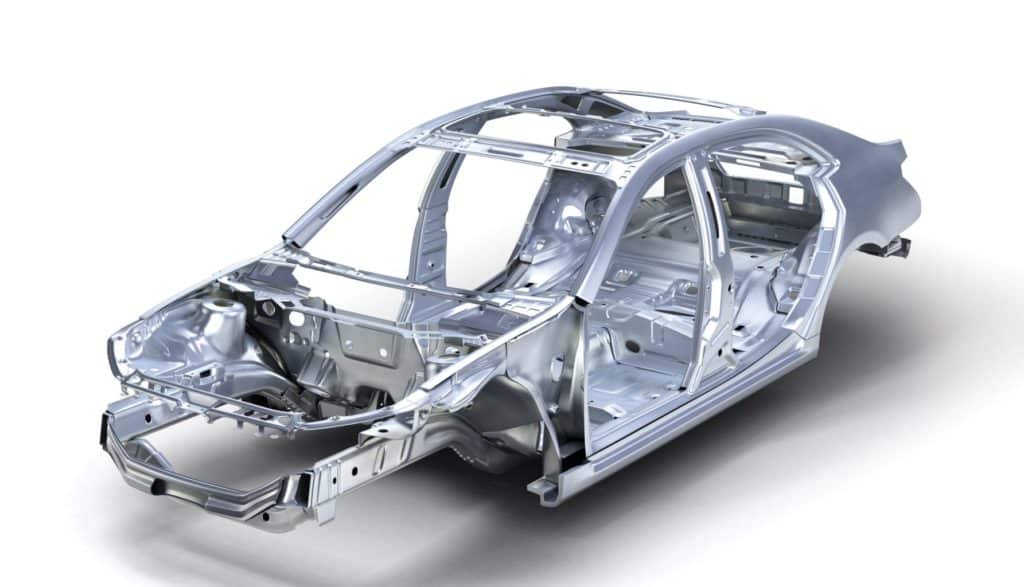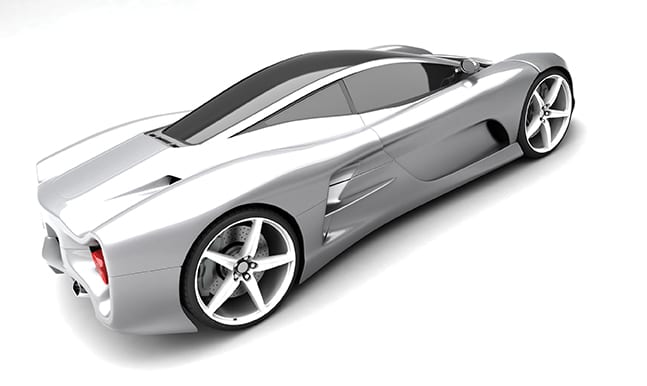by Cynthia Challener, CoatingsTech Contributing Writer
Automotive designs are changing in response to increasingly stringent environmental regulations and constantly evolving buyer preferences. Emission and gas mileage requirements in the United States are steadily rising under the CAFÉ standards. Car manufacturers are responding by replacing traditional steel parts with components made from lighter weight materials. Coating vehicles made from myriad substrates bonded together with adhesives rather than welded joints present significant challenges to both formulators and applicators and are driving innovation across the entire supply chain and vehicle coating process.
Numerous Lightweight Options
Car makers are exploring the use of a wide range of lightweight material alternatives to traditional steel. Some technologies in the forefront include aluminum, ultrahigh strength steel (UHSS), magnesium, carbon fiber reinforced polymers, and various high strength plastics. “Each option carries its own set of benefits and unresolved issues,” says Bill Eibon, director of Technology Acquisition for Automotive OEM Coatings with PPG Industries. New alloys and compositions are being developed in each of these categories to create lighter, stronger, more formable materials, and each is being targeted where they are able to contribute the most value in weight reduction, resulting in multiple materials being used on a given vehicle, according to David Fischer, vice president of Market Strategy and Growth for Axalta Coating Systems.
Multi-Substrate Issues
“No single lightweight material stands ready to displace steel as the largest component,” Eibon asserts. “While prudent, this multi-material approach creates its own set of coating issues,” he continues. Areas that must be addressed include the pretreatment process, the potential for corrosion, compatibility with the adhesives and sealants used to join disparate materials, the need for lower curing temperatures to avoid deformation of composites and plastics, and the greater surface roughness of many of these materials. “As the material content changes and alloys evolve, coatings must be adjusted so they continue to provide a uniform, high quality finish across the vehicle,” Fischer observes. How these materials react to paint shop conditions such as thermal expansion must also be addressed, he notes.
Pretreatment Challenges
Pretreatment is the first coating layer on a car body. Existing pretreatments have been optimized for steel substrates. Today, however, rather than welding debris, excess adhesive and sealant materials need to be removed during the pretreatment of parts comprising different substrates. New wax-based lubricants are used to improve the formability of aluminum parts, but can be challenging to remove during cleaning. These different materials often clog existing filtration systems, according to Jim Schafer, lab manager with Durr Systems.
“Pretreatments require reformulation to ensure uniformity of crystal structures deposited on multiple materials to meet current adhesion and performance specifications, while minimizing sludge formation, waste, and operational inefficiencies,” asserts Eibon. He does note that new pretreatments for aluminum have been developed, while numerous solutions for multi-metal pretreatment are being developed to meet the material choices of each auto manufacturer. “There is definitely a learning curve to determine which technologies work best for newer substrates and different combinations of substrates,” observes Schaefer.
It is very challenging to achieve the same coating quality for all components because the quality of the surfaces of some of the newer materials being used today is lower than that of conventional steel.
When developing new pretreatments, formulators must consider how different chemicals will react with each substrate and the different materials used to join them, as well as how the process will impact coating adhesion to each substrate, according to Scott Clifford, principal engineer in the Paint Shop Automation Group of FANUC America Inc. “The move to multi-material components has added significant complexity to the pretreatment process,” he asserts.
New Corrosion Concerns
The coatings industry has made steady improvements in corrosion protection over the years, according to Eibon. The mixed-material approach to lightweighting, however, brings dissimilar metals in contact, thereby increasing the probability of creating a galvanic cell. “Corrosion resistance will need to be optimized and improved to ensure mixed-metal car bodies meet the current industry standards,” he notes. Corrosion protection for UHSS is a new concern as well, because this material is susceptible to hydrogen-induced cracking that occurs over time. “New corrosion protection systems are being formulated to meet changing characteristics as new alloys are introduced, and when multiple metals are processed through a common system,” Fischer agrees.
Adhesion Problems
One way that car manufacturers are reducing vehicle weight while providing the necessary strength is through the incorporation of lightweight polymeric materials inside pillars in car bodies, according to Jim Pakkala, senior engineering manager for Paint and Final Assembly Systems at Durr Systems. “The polymers have high specific heat values, and, therefore, it can be challenging to achieve full curing of coatings on these pillars,” he comments. Durr is evaluating potential modifications to existing equipment that will enable full curing over the entire car body.
The new plastic and composite systems used today also require adjustments to coating systems to ensure adhesion to modified surfaces without adversely impacting other properties, according to Fischer. “Adhesion to these new surfaces is the largest initial concern that drives coating reformulation today,” Eibon asserts. Electrostatic deposition can be difficult on multi-material components because different capacitances are required to achieve paint adhesion on the different substrates, according to Pakkala. “The industry has to rethink existing solutions and technologies,” he comments. Eibon also notes that the joining and bonding of multiple materials by polymers will require coating solutions that can adhere to these adhesives and sealants and tolerate any materials that off-gas during curing.
Surface Roughness Issues
When multiple substrates are used in a vehicle body, the material joining process is very complicated; creating a uniform body is very challenging, according to Clifford. The surface roughness and existence of residual mold lines on new plastic substrates also negatively impacts the appearance of coatings, and as a result this issue is driving coating reformulation, according to Eibon. “It is very challenging to achieve the same coating quality for all components because the quality of the surfaces of some of the newer materials being used today is lower than that of conventional steel,” Pakkala adds. He notes that additional sanding steps are often included—sometimes of the primer before application of the basecoat, and occasionally of a first clearcoat layer before application of a second. “Sanding creates a lot of additional process work, slows down production, and adds cost—all of which are undesirable,” Pakkala observes.
Low-Temperature Curing Issues
Increasing the content of plastics on cars combined with the desire to coat all assembled parts online requires low-temperature cure coating systems. “The industry is moving rapidly towards an 80°C cure reality,” states Eibon. “All coatings layers will have to be modified as a complete coating system to ensure success of cars cured at this temperature,” he adds. Achieving color matching and uniform leveling and other appearance characteristics for all body parts including those that are baked at lower temperature is challenging, however, according to Schafer. “Paint companies are working closely with OEMs and equipment manufacturers to develop application equipment that can overcome these issues,” he says.
There has already been movement towards the use of two-component coating formulations to decrease curing times and temperatures as well as reduce environmental footprints. FANUC, for instance, has developed a new direct charge rotary atomizer system for the application of 2K waterborne coatings that involves reaction of the polyisocyanate into the water-based basecoat to reduce the curing temperature. “The use of 2K waterborne systems adds a level of complexity that should be considered,” he observes.
Clifford states that if we see more extensive use of plastics and composites in the coming years, we may see less painting in the assembled body position and more parts painted individually or in the “part on fixture” position.
Sustainability Challenges
All of these difficulties must be overcome while maintaining a very high quality coating appearance, without adding cost, and ideally with a reduction in the environmental impact of painting processes. “Painting is the highest cost step in car manufacturing, as well as the process with the highest energy usage and largest environmental footprint. There is consequently significant focus by OEMs on simplifying the process, but without compromising quality. They are looking for higher utilization, efficiency, and productivity despite the significant changes in materials used,” Pakkala explains. In addition to increasing the efficiency of the application process, efforts to reduce the environmental impact of the coating process include reducing the volatile organic compound (VOC) content of the finishes as applied, improving the ability to capture VOCs, and reducing energy use, according to Fischer.
Regulatory Drivers for Innovation
There are a number of different regulatory drivers that coatings manufacturers must be aware of while developing new solutions for multi-material vehicles. In addition to CAFÉ requirements, which are driving a lot of R&D programs for new material development in and outside of coatings, the global trend toward reduction of toxic materials and the use of sustainable and green processes to generate materials and products is influencing coating development, according to Eibon. Fischer adds that eliminating materials of concern continues to be a priority as regulators continue to add new materials to this list. “Negotiating the complex and dissimilar requirements for material registration around the globe is a challenge for all coatings producers and users. The increase in material registration requirements and legislative compliance has been well documented and will continue to drive coatings activities and costs into the future,” Eibon asserts.
Consumer Preferences
Of course, coating manufacturers and car makers must also keep buying preferences at the forefront of any new technology development efforts. “Consumers continue to want to be delighted with new and fresh designs, including colors with unique effects. Development of new color spaces and programs that offer color in new and interesting ways continues to be a focus,” says Fischer.
In fact, the automotive industry has established two-tone and dissimilar color design elements as a way to increase customization for mass produced vehicles, according to Eibon. “A growing number of consumers are willing to select premium colors when the options are available,” he notes. He adds that the resurgence of aggressive-looking muscle cars with 21st century technology brings a need to paint gloss and matte accent stripes. Roof coatings of different colors, geometric designs, or with solar reflectance have become popular recently. “All three of these design concepts currently require complex manual masking and de-masking applications that add cost and slow production. Automotive OEMs, coatings companies, and paint application equipment manufacturers are developing maskless spray technologies to deliver these design concepts without losing capacity. A reduction in paint overspray from different atomizers is predicted, which—if successful—should lead to reduced material waste,” Eibon explains.
Improvements in coating performance would also be beneficial, according to Fischer. “Today’s coatings are not perfect. Improvements in stone-chip resistance, appearance, scratch and mar resistance, and resistance to chemical attack (acid rain, bug proteins, road grime, etc.) can reduce warranty claims and add value through improved consumer satisfaction and higher residual values,” he states.
Coatings for the interiors of vehicles face similar challenges. “As with car exteriors, new and multiple materials are being used in vehicle interiors, and a uniform look and feel is needed across different surfaces. In addition, coatings for vehicle interiors will need to provide high resistance to chemicals such as sunscreens, mosquito repellants, and air fresheners, despite being applied to different substrates,” Fischer observes. He also notes that, in the future, it is anticipated that people will spend more time being entertained and less time driving as autonomous vehicles begin to populate the roads. “These cars may also be shared, leading to different use and maintenance schedules. As a result, coatings for car interiors will also need to be designed for a new driver/passenger experience.”
CoatingsTech | January 2017 | Vol. 14, No. 1

